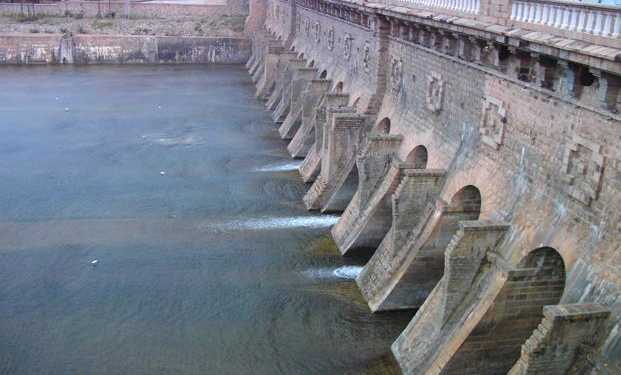The heated dispute over the Kaveri River has divided the populations of Karnataka and Tamil Nadu for more than two centuries, and to an extent that each generation of people alive in those states today have witnessed crisis come as a result multiple times. The situation has always been dire, but never resolved.
The dispute dates back to the time of the British raj, for the river originated in the independent Kingdom of Mysore, but found its way into the British presidency of Madras, who, coupled with British support and technology, had plans to organize the Kaveri’s reserves, while Mysore too had plans for irrigation projects. But dealing with flooding and famine in those regions during the 1870’s kept the British Empire busy, essentially robbing Madras of funds, while Karnataka’s irrigation projects never came to fruition either.
As the 19th century’s end approached, the states then focused on restarting their projects, but neither wanted the other to succeed. Thus, the Mysore Kingdom took the issue to the Empire, who made the kingdom and Madras sign an agreement in 1892, while another agreement had to be signed in 1924 after both states resisted the idea of either constructing dams.
But the groundwork for Tamil Nadu and Karnataka’s modern battle over the Kaveri was only laid after the post-independent delineation of states in 1956.
The central government realized that the Kaveri wouldn’t be the only river shared by multiple states, each of which would be more dependent on particular rivers than the others, and thus, the parliament passed a new act for the constitution.
The 1956 interstate water disputes act said that if the states competing for the rivers within their landmasses were incapable of reaching a sound conclusion, a special tribunal would be formed with the purpose of delivering a decision.
In 1974, the agreement over the Kaveri that the Mysore Kingdom and Madras presidency had signed half a century ago came to lapse and Karnataka looked to construct a new dam on the Kaveri. Unhappy with the construction, Tamil Nadu utilized the water disputes act immediately, but a special tribunal would only be formed after a decade of talks in 1980’s between both states broke down without conclusion, for the Tamil government was desperate for action to be taken after its farmers agitated.
Once the three man tribunal was formed, the Karnataka government demanded a share of water larger than the state had ever claimed, while the Tamil Nadu government wanted the share of water stated in the 1924 agreement, which would grant them nearly three quarters of the water, to be replicated in the tribunal decision.
The Mysore Kingdom had, of course, agreed to depart with three quarters of its water then, and the tribunal required the Karnataka government to come up with an explanation on how the Mysore Kingdom agreed to the treaty, and managed with the menial amount of water granted to them, but they couldn’t. The Karnataka government argued that the British Empire simply forced Mysore into departing with a majority of the Kaveri’s water, while the fear of British action compelled them to not stage a protest against the decision, despite their needs.
The interim tribunal conclusion arrived in 1991, which dictated that Karnataka would have to grant Tamil Nadu an additional 205 TMC (thousand million cubic feet) of water.
The Supreme Court refusing to hear Karnataka’s arguments against the decision led to widespread protests occurring over the course of 1991’s monsoon, another year where a sore lack of rains agitated farmers, while anti-Tamil sentiment crept into daily life.
In the summer, thousands of Tamil families would lead an exodus out of Karnataka, particularly Bangalore, after suffering from an epidemic level of violence and bias stemming from the tribunal decision.
In Tamil Nadu though, for various ruling parties capitalized on the great influx of water due to the 1991 interim order and allowed thousands of farmers to settle along the Kaveri’s banks, who relied on three staple yet heavily water dependent crops – sugarcane, rice, and paddy. Karnataka too permitted this to happen to an extent, and meant that both states were now eternally at the mercy of rains.
Monsoons were highly dissatisfactory almost every other year in the 1990’s, and various Supreme Court and tribunal decisions over the Kaveri were met by criticism from both states.
But 2016’s different, for global climate change has significantly altered the quality of monsoons which were already lacking, Kaveri water levels are very scarce, and emerging studies about Indian weather patterns reveal that prolonged periods of minimal rainfall, that worsen the dispute, always end with an excess of rainfall, which can sometimes be destructive.
In Karnataka, the fear of water scarcities arising due to an increased amount of water being granted to Tamil Nadu inspires politicians and their supporters to protest. The state relies on the Kaveri for much of its drinking water, and the sense of ownership is such that even political opposition unites with the state government to take a stand against each of the tribunal’s decisions, but rioting and vandalism coming as a result are left untended.
Yet, both state’s governments aren’t diametrically opposed to each other, for even though every single one of the tribunal’s decisions have directed Karnataka to release more water for Tamil Nadu, they haven’t ever refused to comply outright, and have only protested against the amount they have to release.
The real problems arise whenever politicians seek to gain benefits from the shortages of water. For two decades, the narrative has been identical, beginning with an unusually horrid monsoon season, which leads to agitation within the farming community along the Kaveri’s banks, whose profits completely vanish in the absence of rainfall due to their overreliance on it. That emotion is then capitalized on by politicians, by whom the issues are then purported to be of regional pride, and nationalism takes a backseat as the need to oppose the neighboring state takes a hold over the local populations.
Had the sustainment and protection of the Kaveri been on the top of the politicians’ agendas, disputes over it wouldn’t decline between years of tribunal verdicts or court decisions because the problems are clearly ever-present. Rather, talks would be held with respect in abundance each time a problem arose.
The worst by-product is that the dispute over the river grants people of no relation to actual farmers the right to be enraged every other year.
But the state governments are to be blamed for the violence too, for each of the protests conducted over the years have reduced significantly within a matter of weeks, and peace talks resume soon enough. And yet, the governments have no preventive measures whatsoever, while no solutions or ideas are thrown about as to how the dispute can be handled rationally, and politicians in power simply stay put until the storm arrives at their office.
The rioting is birthed with the belief that there’s a quick solution to the problem, but there really isn’t one. The issue can’t exactly be resolved in the Supreme Court either, as one state being granted a greater share of water will result in another one listing their needs and the legal process would restart once again. In fact, this has already happened.
On September 5th this year, the Supreme Court ordered Karnataka to release an additional 15,000 cusescs of water for Tamil Nadu. On the 12th of September, the amount was reduced to 13,000, and by the 19th, it was a mere 3,000. Yet, Siddaramaiah argues that his state can’t afford to comply.
Both states have to opt for preventive measures and scientific techniques, while ratcheting back on the policies and decisions that made their farmers over reliant on the Kaveri in the first place. Yet, a combination, or multiple, of these measures would need to be taken, for cruel monsoons can single handedly thrash expectations.
Among the plethora of suggested solutions to the problem, the general public seems to fancy idea that popped up thirty years ago the most – the interlinking of Indian rivers.
An effectively established network of rivers would make it easier for water to reach areas suffering from scarcities, or those ravaged by droughts, while inland trade too could benefit.
Yet, environmentalists argue that the interlinking of rivers, beneficial as it may sound, must only ever be the last resort, for huge human displacements and great loss of marine biology would certainly take place. Further, the cost would be such that the mere act of convincing Parliament to allow funding would take months, if not years.
Also, thinking that the interlinking of rivers would actually bear fruit is based upon the presumption that any of the Indian rivers even have an excess of unutilized water, and the plan of interlinking wouldn’t be worth much if states are not ready to part with their native river’s water, even if they receive a fair share, which holds true with many river disputes.
Another alternative is water desalination, which would make much more of the Kaveri’s water suitable for drinking, although the energy requirements and monetary costs of maintaining plants and operations are rich to say the least, with estimates suggesting that operations might cost both states thousands of crores. This is, in part, due to water desalination not having been adopted widely around the world, for public interest would compel those involved to birth ways of further reducing costs. But an Indian state already utilizes the technique, for the Gujarat government has established various desalination plants within the state’s confines, and their success could inspire the central government to emulate the scheme around the Kaveri, and the remainder of India too.
Whereas ensuring people in cities aren’t lacking water is concerned, in 2001, Tamil Nadu’s chief minister Jayalalithaa made rain water harvesting mandatory for each building, and the scheme resulted in previously depleting groundwater levels in Chennai shoot up by 50%.
That’s a surprisingly effective scheme for a state whose demands for more water are feared by many, as Tamil Nadu has a history of chronic mismanagement and inefficiency when it comes to water resources.
In Tamil Nadu, sand from the Kaveri’s riverbed is smuggled by cartels into the Keralan border and sold at almost 3 to 4 times the actual prices. Although the crackdown on sand smuggling has been initiated by both states in question, it was the Tamil Nadu government’s ignorance towards the act that let it go unquestioned in the first place, though many claim that smuggling is state sponsored, as cartels often fund political parties.
Then, of course, the disastrous floods in Tamil Nadu last year too came about as a result of the state having shortsightedness whenever the matter at hand concerns water. Tamil Nadu had been home to over twenty four years of booming and unplanned development, for the state had prospered due to economic liberalization in 1991. But the hunger for industrial infrastructure overshadowed nature, robbing cities such as Chennai, which had doubled in size during the past two decades, of their natural buffers and filters for excessive water levels, for they had been eradicated completely.
Down the years, Karnataka too made rain water harvesting compulsory, and although the rains have been depreciating recently, the phenomenon commonly attributed to the lack of them, the El Nino effect, seems to be wearing off, meaning that Tamil Nadu and Karnataka’s decision to favor rainwater harvesting might soon be rewarded.
If the Supreme Court upholds its previous decision on the matter, the government of Karnataka will be handed the task of convincing its population not to unnecessarily protest against Tamil Nadu’s needs, while Jayalalithaa’s government will have the task of being prudent with the greater influx of water into the state.
The central government too has a role to play, for statistics and data collection methods aren’t the greatest in India, and make it harder for water levels to be judged, or predicted, at any time. The central government would need to help change this to prevent illicit activities on behalf of, or being committed in, any state not being accounted properly.
Right now though, perhaps the easiest short term method to deal with the current scarcity is to introduce an effective way of sharing the Kaveri’s water between both states, in accordance with their needs.
For this to happen, an institution with the sole purpose of monitoring the exchange of water, or even controlling the dams themselves, would need to be established.
The farmers are the ones that suffer the consequences of lackluster planning and oversight, and the responsibility to resolve their problems lies in the hands of Karnataka and Tamil Nadu, and although implementing the aforementioned solutions might take up time and resources, the end product will emancipate thousands from their problems.


































